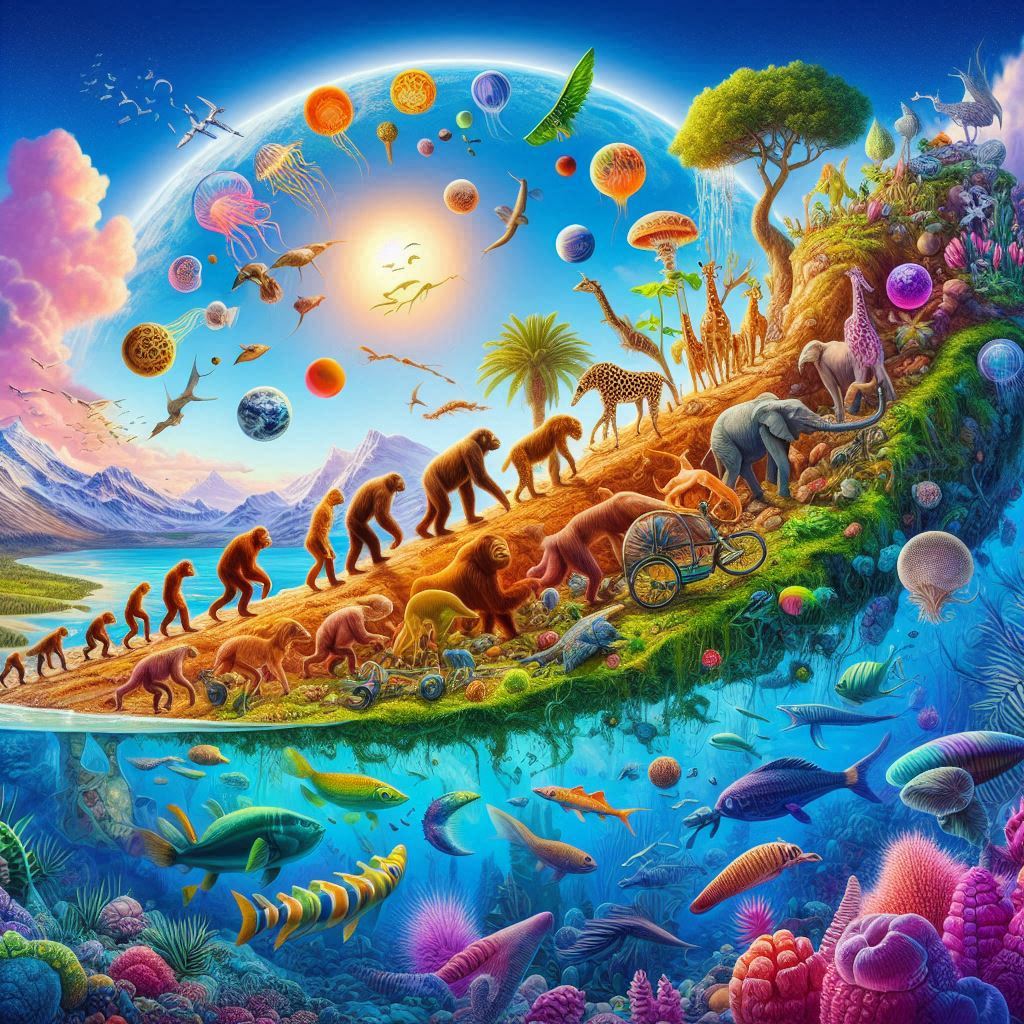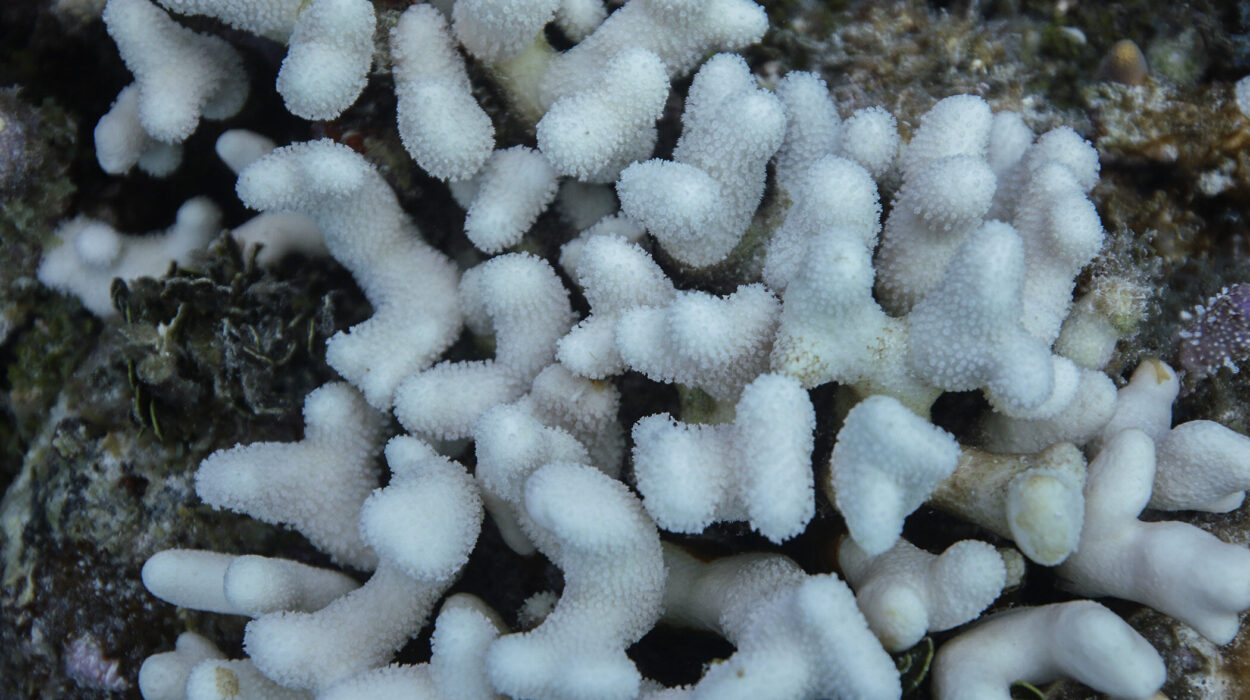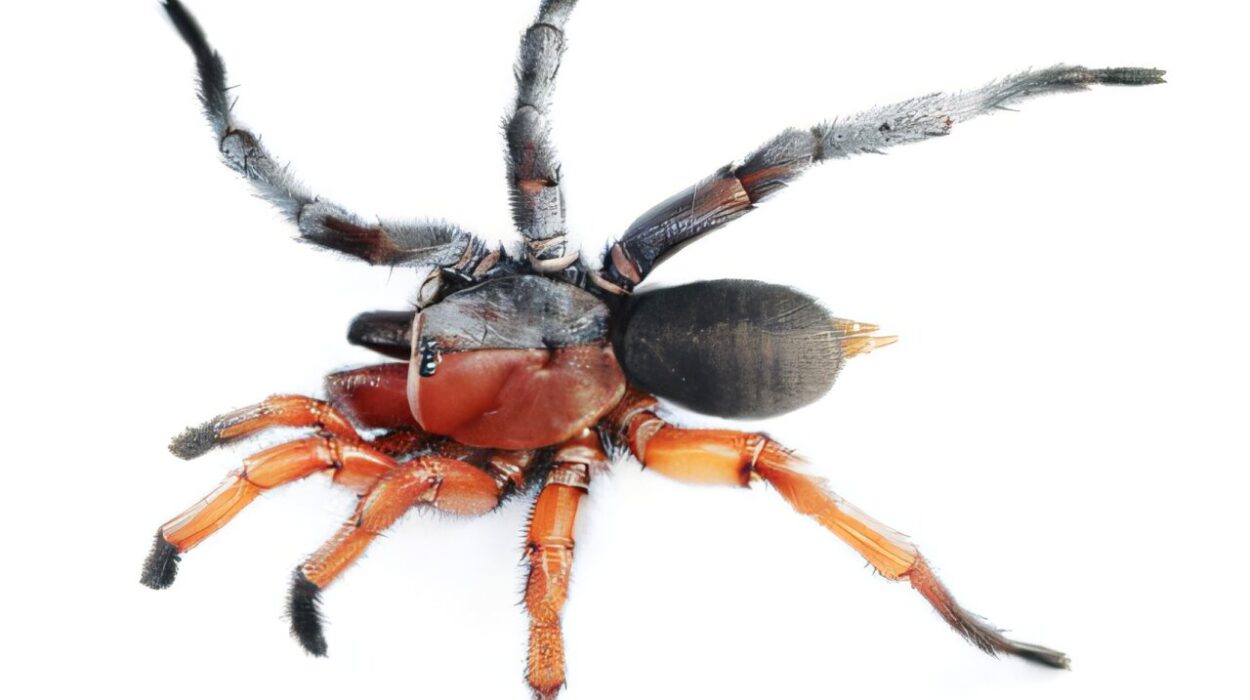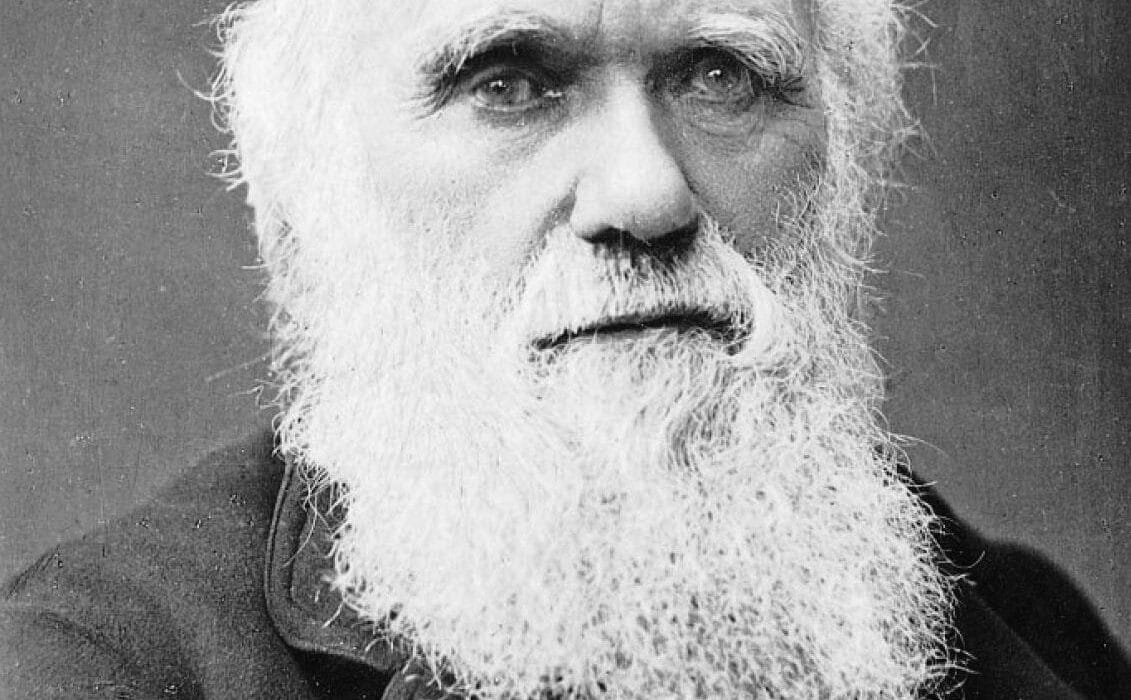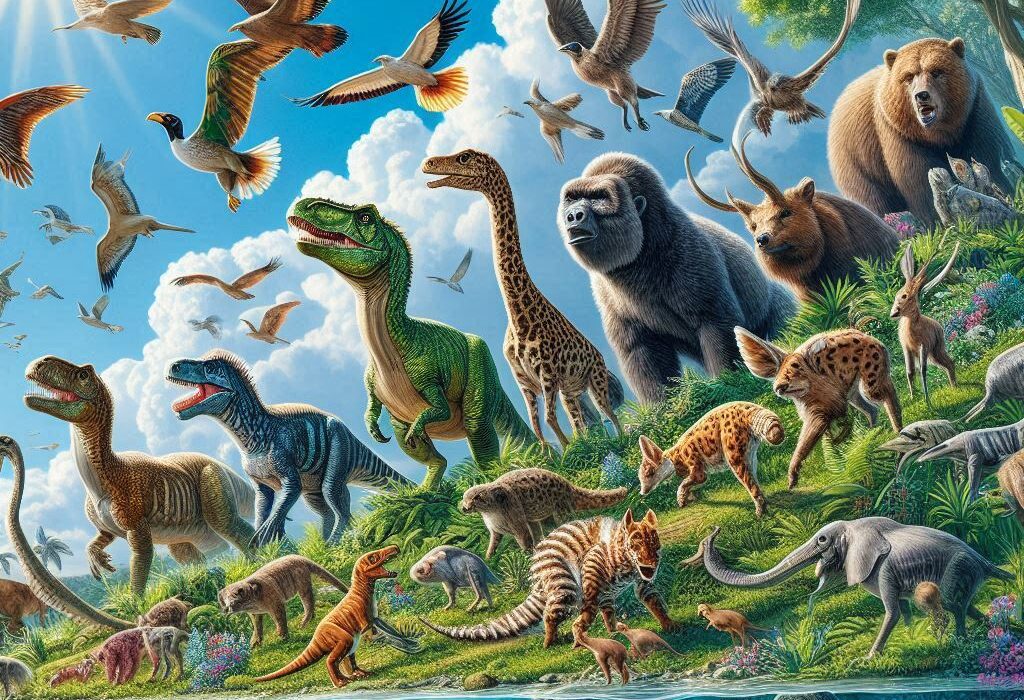The evolution of life on Earth is one of the most awe-inspiring and complex stories ever told, spanning billions of years of transformation, adaptation, and survival. From the earliest moments of the planet’s formation to the present day, life has been shaped by a vast array of forces, from cosmic events to the slow, patient processes of natural selection. This journey began over 4.6 billion years ago when Earth was a lifeless, chaotic mass of rock and gases. Over time, the conditions for life began to take shape, allowing the first single-celled organisms to emerge in the oceans. From there, life would evolve into increasingly complex forms, overcoming massive challenges such as global extinction events and dramatic environmental shifts.
The development of plants, animals, and eventually humans has been driven by innovation at the genetic level, leading to an unparalleled diversity of species that now inhabit every corner of the planet. Yet, despite this vast history of evolutionary success, humanity’s rise has brought about significant changes to Earth’s ecosystems and climate, highlighting both the power and the responsibility we hold in shaping the planet’s future. This article will explore the incredible timeline of life’s evolution, shedding light on the milestones that have defined life on Earth.
The Formation of Earth: A Hot and Chaotic Beginning
Our story begins nearly 4.6 billion years ago when Earth was born from a swirling cloud of dust and gas. This cloud, left over from the formation of the Sun, began to collapse under its own gravity. As the dust and gas collided, they formed rocky particles, which eventually came together to form our planet. Early Earth was a violent, inhospitable place—molten rock, intense volcanic activity, and constant bombardment by asteroids and comets. It wasn’t until about 100 million years later that the Earth began to cool, allowing the formation of oceans and a primitive atmosphere.
At this point, Earth was essentially a vast ocean of liquid water and molten land, and the basic ingredients necessary for life—water, carbon, nitrogen, and various minerals—were all present. The stage was set for the origin of life itself.
The Origins of Life: The First Sparks of Existence (4.0 – 3.5 Billion Years Ago)
Life on Earth began in the oceans around 4.0 to 3.5 billion years ago. While the exact origin of life remains a subject of scientific debate, the most widely accepted theory is that life began through a series of chemical reactions in Earth’s primordial oceans, perhaps catalyzed by lightning or volcanic activity. The first life forms were simple, single-celled organisms known as prokaryotes. These were microscopic and lacked a nucleus, making them structurally simpler than the cells we are familiar with today.
The first prokaryotes were likely anaerobic, meaning they did not require oxygen for survival. Instead, they utilized other chemical compounds, such as sulfur and methane, in the Earth’s primordial atmosphere. These organisms, though simple, were the foundation upon which all complex life would eventually evolve.
One key breakthrough came in the form of metabolism, the process by which organisms break down food to produce energy. These early prokaryotes developed the first biochemical processes that allowed life to thrive, even in the harshest of conditions. But life, as simple as it was, had to face another crucial challenge—the availability of energy.
The Dawn of Photosynthesis: A Radical Shift (3.5 – 2.4 Billion Years Ago)
Around 3.5 billion years ago, some prokaryotes developed a process that would revolutionize life on Earth—photosynthesis. By harnessing sunlight, these organisms could produce their own food, creating an energy cycle that was vastly more efficient than earlier forms of metabolism. As a byproduct of photosynthesis, oxygen was produced, which began to accumulate in the oceans and the atmosphere. This shift marked the beginning of a profound transformation for life on Earth.
Initially, the oxygen produced by photosynthesis reacted with iron and other minerals in the ocean, forming iron oxide and precipitating out of the water. However, once the oceans became saturated with oxygen, this gas began to accumulate in the atmosphere, forever altering the planet’s composition.
This rise in oxygen eventually led to what scientists call the Great Oxygenation Event, which occurred around 2.4 billion years ago. This event is considered one of the most pivotal moments in Earth’s history. Oxygen, once toxic to many forms of life, began to accumulate in the atmosphere, creating a new environment that allowed for the development of more complex, oxygen-dependent life forms.
The Great Oxygenation Event: The Dawn of New Possibilities (2.4 – 2.0 Billion Years Ago)
The rise in oxygen levels triggered one of the first mass extinctions in Earth’s history, known as the Oxygen Catastrophe or Great Oxygenation Event. Many of the early anaerobic organisms, which could not survive in an oxygen-rich atmosphere, were wiped out. But this event also opened the door for new forms of life to flourish.
In response to this changing environment, life began to evolve new mechanisms to cope with oxygen. Some organisms developed the ability to use oxygen in their metabolism, leading to a more efficient form of energy production known as aerobic respiration. This allowed organisms to grow larger and become more complex. As a result, the stage was set for the emergence of eukaryotes—more advanced cells with specialized internal structures.
The Rise of Eukaryotes: Complexity at a Cellular Level (2.0 Billion Years Ago)
Around 2.0 billion years ago, the first eukaryotic cells appeared. These cells were significantly more complex than prokaryotic cells, containing internal structures known as organelles, including a nucleus that housed the organism’s genetic material. Eukaryotes were able to perform a much wider variety of functions within their cells, leading to more sophisticated ways of interacting with their environment.
The origin of eukaryotes is thought to have resulted from a process called endosymbiosis—where one organism engulfs another, and instead of digesting it, a symbiotic relationship forms between the two. In this case, early eukaryotes are believed to have engulfed bacteria, which eventually evolved into specialized organelles like mitochondria (involved in energy production) and chloroplasts (involved in photosynthesis, in plants).
The emergence of eukaryotes was a turning point. It set the foundation for the development of multicellular life, and soon after, complex life forms began to arise.
The Evolution of Multicellular Life: From Single Cells to Complex Organisms (1.6 Billion Years Ago)
While eukaryotes represented a leap in cellular complexity, the real revolution came when single-celled eukaryotes began to join forces and form multicellular organisms. Around 1.6 billion years ago, the first multicellular life forms appeared. These organisms were able to specialize cells for different functions, which allowed them to grow larger and live in more diverse environments.
Early multicellular organisms were likely simple colonies of cells, working together for the greater good of the collective organism. This development set the stage for the wide diversity of life forms that would emerge in the future, from simple algae to complex animals and plants.
One of the critical innovations of multicellularity was the ability to pass on specialized functions from one cell to another. This led to the differentiation of cells, tissues, and organs—a vital step in the rise of more complex, multicellular organisms.
The Cambrian Explosion: A Burst of Life and Biodiversity (541 Million Years Ago)
Around 541 million years ago, a sudden explosion of life occurred, known as the Cambrian Explosion. During this brief period of geological time—just 20 to 25 million years—nearly every major animal phylum we know today emerged. The Cambrian Explosion marked a radical departure from the relatively simple life forms of earlier periods, as animals began to evolve more sophisticated body structures, sensory organs, and behaviors.
In the Cambrian seas, life exploded into new and varied forms. Some creatures developed exoskeletons for protection, others developed the ability to swim or burrow into the ocean floor. The appearance of complex body plans and new anatomical structures—such as eyes, legs, and specialized appendages—allowed animals to exploit new ecological niches.
The Cambrian Explosion set the stage for the rise of more familiar animals, including arthropods, mollusks, and the early ancestors of vertebrates. It marked the beginning of an era of unprecedented biological innovation, as life on Earth rapidly diversified.
The First Plants and Animals on Land (485 Million Years Ago)
Life was thriving in the oceans, but it would take another 40 million years for life to begin its conquest of land. Around 485 million years ago, the first land plants appeared. These were small, non-vascular plants, similar to modern-day mosses, which were able to survive on land due to their ability to absorb water from the ground and withstand the drying effects of the air.
Shortly after the emergence of land plants, arthropods—the ancestors of insects, spiders, and crustaceans—began to invade land. These early arthropods were able to survive on land because they had evolved exoskeletons to prevent desiccation and structures that allowed them to breathe air. The invasion of land by these organisms marked the beginning of terrestrial ecosystems.
Over the next 100 million years, more plants and animals would evolve to exploit the terrestrial environment. By the Devonian Period (around 400 million years ago), the first vertebrates—fish-like creatures that had adapted to life on land—began to appear, marking the beginning of the evolutionary lineage that would eventually lead to amphibians, reptiles, mammals, and birds.
The Age of Dinosaurs (230 Million Years Ago – 66 Million Years Ago)
The Mesozoic Era, often referred to as the “Age of Dinosaurs,” began around 230 million years ago. During this time, dinosaurs became the dominant group of animals on Earth. They evolved into an astonishing variety of species, from small, bird-like dinosaurs to the towering, long-necked giants such as Brachiosaurus and Diplodocus. Some dinosaurs, like Tyrannosaurus rex, were apex predators, while others, like Triceratops, were herbivores.
The Mesozoic Era is divided into three periods: the Triassic, Jurassic, and Cretaceous. During this time, life flourished in diverse ecosystems, from lush jungles to vast deserts. Birds, which are the descendants of certain dinosaur species, began to evolve toward the end of the Mesozoic, and the first mammals also emerged.
The age of dinosaurs came to a dramatic end around 66 million years ago when a massive asteroid struck Earth, leading to the Cretaceous-Paleogene (K-Pg) extinction event. This event wiped out approximately 75% of Earth’s species, including the non-avian dinosaurs, allowing mammals to rise to prominence in the aftermath.
The Rise of Mammals and the Evolution of Humans (66 Million Years Ago – Present)
With the extinction of the dinosaurs, mammals began to flourish. Initially small and nocturnal, mammals evolved into a wide range of forms, from rodents to larger, more complex animals like elephants, whales, and primates. The emergence of warm-blooded metabolism and fur allowed mammals to thrive in a variety of environments, from cold tundras to hot deserts.
Around 60 million years ago, the first primates began to evolve. These small, tree-dwelling creatures developed larger brains and more complex social structures, traits that would prove crucial for the development of humans.
Over millions of years, the genus Homo emerged, with species like Homo habilis and Homo erectus paving the way for the eventual appearance of Homo sapiens—modern humans—around 300,000 years ago. The evolution of language, abstract thinking, and tool use allowed humans to create complex cultures, build civilizations, and transform the planet in ways that no other species had before. As humans developed agriculture, cities, and advanced technologies, we became the most influential species on Earth, reshaping ecosystems, and driving extinction events through our actions.
The Rise of Human Civilization (10,000 Years Ago – Present)
Around 10,000 years ago, during the Holocene Epoch, human societies began to transition from nomadic hunter-gatherer lifestyles to settled agricultural communities. The development of farming allowed human populations to grow and thrive, leading to the establishment of the first cities and the dawn of civilization. This marked a pivotal moment in Earth’s history, as human innovation and creativity began to drastically alter the environment.
The ability to domesticate animals and plants led to more stable food supplies, which allowed civilizations to grow larger. Early humans started to build complex social structures, develop writing systems, create art, and engage in trade. Ancient civilizations such as those in Mesopotamia, Egypt, the Indus Valley, and China began to develop technologies that shaped the course of history. From the invention of the wheel to the creation of early metalworking techniques, humans were constantly evolving and innovating.
Throughout the Middle Ages and the Renaissance, the development of science, philosophy, and technology advanced rapidly. The invention of the printing press in the 15th century revolutionized the spread of knowledge, leading to the Scientific Revolution, which fundamentally changed humanity’s understanding of the natural world. With the rise of industrialization in the 18th and 19th centuries, humanity began to exert unprecedented control over the Earth’s resources. Industrial agriculture, fossil fuel extraction, and urbanization radically transformed ecosystems and led to significant environmental challenges.
The Anthropocene: Humanity’s Impact on the Earth (1800s – Present)
In the last few centuries, particularly since the Industrial Revolution, humans have become the dominant force driving environmental change. This period of significant human influence on the planet has been dubbed the Anthropocene—a term that suggests human activity is now a major geological force. Human actions have led to widespread environmental degradation, climate change, deforestation, and the mass extinction of species.
The burning of fossil fuels has increased atmospheric carbon dioxide levels, contributing to global warming. Deforestation and urbanization have reduced natural habitats, leading to the extinction of many species and the fragmentation of ecosystems. Pollution, especially plastic waste, has become a global crisis, impacting marine life and terrestrial ecosystems alike. The rise of industrial agriculture has led to the depletion of soil, water, and biodiversity, making it increasingly difficult to sustain the growing human population.
Despite these challenges, humanity has also made significant strides in addressing environmental issues. Movements for environmental conservation, the development of renewable energy technologies, and efforts to protect endangered species and ecosystems have gained momentum in recent decades. Climate change agreements, such as the Paris Agreement, have aimed to reduce global carbon emissions, though much work remains to be done.
The Future of Life on Earth: Evolution Continues
As we look to the future, life on Earth will continue to evolve. While human influence has caused significant disruptions to ecosystems and the climate, life itself is incredibly resilient. Evolution does not stop, and in the face of climate change and other challenges, new species will emerge, and ecosystems will adapt in ways we cannot yet predict.
However, the future of life on Earth is uncertain. The choices humanity makes in the coming decades will determine the trajectory of life on our planet. Will we manage to reduce our impact on the environment and protect biodiversity, or will the pressures we place on the planet lead to further destruction? The continued survival of many species depends on our ability to mitigate the effects of climate change, preserve natural habitats, and restore balance to the Earth’s ecosystems.
The next great era of life on Earth may not belong to humans, but to the many species that will emerge in the wake of our civilization. In this regard, life on Earth will continue to evolve, driven by the same processes that have shaped its history for billions of years: natural selection, genetic mutation, and adaptation.
Conclusion: The Continuum of Life’s Evolution
The evolution of life on Earth is a vast and intricate journey that has unfolded over billions of years, shaped by dramatic shifts in the environment, genetic changes, and the ever-present force of natural selection. From the first simple molecules to the complex and diverse organisms that inhabit the planet today, life has adapted and transformed in response to changing conditions, environmental pressures, and catastrophic events.
Each chapter of Earth’s history has been marked by milestones—significant innovations and changes that have allowed life to thrive, survive, and diversify. The rise of photosynthesis, the development of eukaryotic cells, the emergence of multicellularity, and the explosive diversity during the Cambrian period are just a few of the many pivotal moments that have shaped life as we know it.
Humans, in the grand context of Earth’s history, are but a recent addition to the planet’s evolutionary story. However, our species has undoubtedly become one of the most influential forces on Earth, capable of shaping the future of life for generations to come. Our responsibility is clear: to understand the evolutionary processes that have brought us to this point, to recognize the impact we have on the planet, and to take action to ensure that life on Earth continues to flourish for millennia to come.
As we continue to explore the mysteries of life and the universe, one thing is certain: life on Earth is a story that is still unfolding. With every passing moment, evolution continues, and the future remains an open book, waiting to be written.
